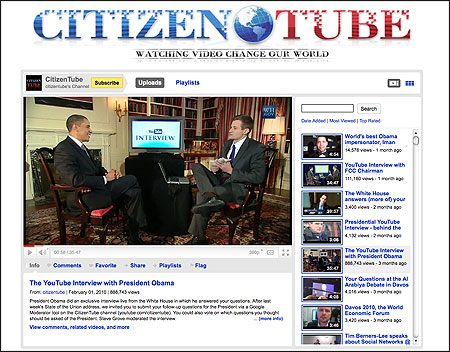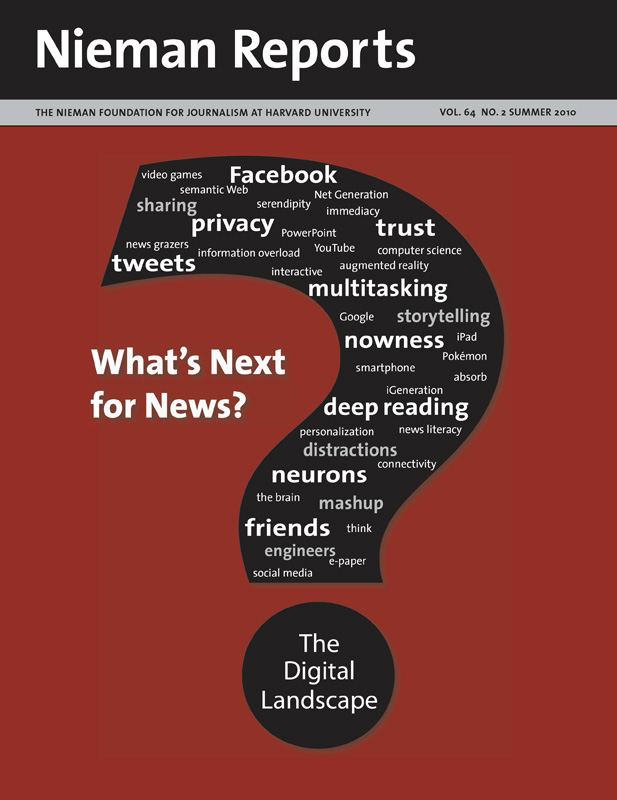
YouTube Direct enables news organizations to ask for, look at, and rebroadcast news footage from YouTube on their own site.
A glance at YouTube might give the impression that it’s a jungle in there. After all, with 24 hours of video uploaded to YouTube every minute, the constantly flowing stream of content can feel overwhelming, even chaotic. With raw footage, video mashups, parodies, cultural memes, and viral hits—staying on top of it all and determining what’s relevant can seem like mission impossible.
Now take a closer look, dig beneath the chaos, and an evolving order is revealed—one that is driving content through the broader ecosystem, which is changing the ways we communicate and get information. At YouTube, we are busy developing tools to help news organizations and consumers navigate this ecosystem. Before peering into the tool box, let’s get acquainted with the key players that make the YouTube news ecosystem unique. Here is the cast of contributors:
- Citizen reporters: Our most frequent contributor is someone who captures an event on video and uploads it to YouTube. (I don’t use the words “citizen journalist” because I don’t think any person who happens to take video of something is necessarily practicing journalism, a skill that requires some training.) Citizen reporters are ensuring that many more events around the world are being captured on video now, and through YouTube, they reach a global audience.
- Clip-cutters: These are people who find the most salient moments from cable news programs, C-SPAN, public archives, or other sources, and upload these clips to the site. Sometimes the insights revealed in these clips inspire more people than the original content did. Often this happens because the original producer was busy packaging the entire show instead of looking for moments of significance to which a broader online audience will respond.
- Mashup artists, video bloggers, admakers and musicians: These people influence the public discussion on any number of topics with their video commentaries.
- Curators: They are trend spotters who don’t upload videos at all, but instead discover interesting content and embed, tweet, e-mail and share it on Facebook.
- Viewers (a.k.a. all of us): We watch the videos, rank them, and share them, thereby driving up view counts and giving the videos exposure on the most-viewed pages of YouTube.
Media organizations enter this YouTube ecosystem most effectively when they leverage the work of these curators to find what’s important. Top videos—discovered and promoted by YouTube’s grass-roots community—are rebroadcast on TV and other platforms, especially when news organizations don’t have their own footage of an event. Or they might find the commentary on YouTube a useful way of looking at an issue.
The most memorable example occurred last June when foreign media were kicked out of Iran in the wake of the presidential election. Iranians then provided the visuals and words to tell the world about the clashes between police and protesters. But each day there are numerous YouTube videos broadcast on television and cable stations—on topics ranging from the serious to the silly. In fact, TV viewers who see a YouTube clip will sometimes circle back to our Web site to watch the entire segment and search for related content—thus refueling YouTube’s ecosystem.
The incentive for broadcasters and YouTube to create this ecosystem is simple: Those who upload their video to YouTube want broader exposure on TV and the broadcasters want to expand the scope of their reporting and to stay on top of the cultural zeitgeist that is YouTube. But there are business reasons, too. Leveraging citizen reporting, in particular, is efficient; when it works well, news organizations don’t need to send a satellite truck to the scene of every possible news event. In all likelihood, someone was already there and took video on their mobile phone.
For politicians, activists and nonprofits, posting a video is the 21st century press release that affords them free media opportunities. News Web sites can link to it and TV stations can use it. Of course these videos— designed to promote the message of those who produce them—will not serve the public interest in the same way that a news report would.
Media organizations, in turn, post their content on YouTube in an attempt to gain new viewers, revenue and exposure. Like any other partner on YouTube, news organizations can use our content identification and management tools—Content ID—to find and claim user videos (like the mashups uploaded by clip-cutters). Then they can choose what they want to happen next—they can block the video, leave it up and monitor it, or even make money from it. Increasingly, news organizations are seeing the value in leveraging this organic user activity; the majority of media companies using Content ID choose to make money from user clips, rather than take them down.
Steve Grove moderated an interview with President Barack Obama that was streamed live from the White House earlier this year. YouTube users submitted questions by text and video and cast votes to determine which ones Obama was asked.
YouTube’s Tool Chest
There are some challenges to the YouTube news ecosystem for consumers and for news organizations, particularly when it comes to news footage shot by citizen reporters. If it is taking too long for the grass-roots community to surface content, there are ways to find content faster, to verify its authenticity, or to request a particular video that might not already be on the site.
Two of the most recent platforms we’ve built are:
- YouTube Direct: Launched last fall, YouTube Direct is an open source platform that enables news organizations to request, review and rebroadcast news footage collected on YouTube, right from their own site. The Washington Post, ITN, ABC News, Gannett, the Tribune Company, The Huffington Post, and others have used the platform at www.youtube.com/direct to create their own citizen assignment desks.
- Google Moderator: The voting platform we used to collect citizens’ questions for YouTube’s interview with President Barack Obama earlier this year is now available to any YouTube user. With a few clicks at www.google.com/moderator, news organizations can create a dynamic, democratic discussion on any topic.
Every day we explore more ways to enhance the news ecosystem on YouTube. This summer we’re running a YouTube News Lab with the University of California at Berkeley’s Graduate School of Journalism to find out even more. Working with three students and several local news partners, we are experimenting with a newsfeed of citizen-reported videos to help news organizations locate relevant content. And we’re working on a hyperlocal news partnership in San Francisco with CBS affiliate KPIX-TV to cover as much of the city’s news as possible through citizen-reported videos. (Stay tuned to our news and political blog, www.citizentube.com, to find out more.)
If there’s one thing we know about news on YouTube, it’s that things happen quickly. Our users innovate at an extraordinary pace and in ways that amaze us, make our world more transparent, and change the way we consume information and are informed. As news organizations continue to evolve and develop new business models, YouTube will undoubtedly be a part of their strategy. With so much content to explore, creative minds are now seeking ways for us to find what we think we’re looking for. It may feel like a jungle out there, but we find better ways to explore it every day.
Steve Grove is the head of news and politics at YouTube. He developed the CNN/YouTube debates and the YouTube Direct citizen reporting platform. He tweets @grove and blogs at www.citizentube.com.



